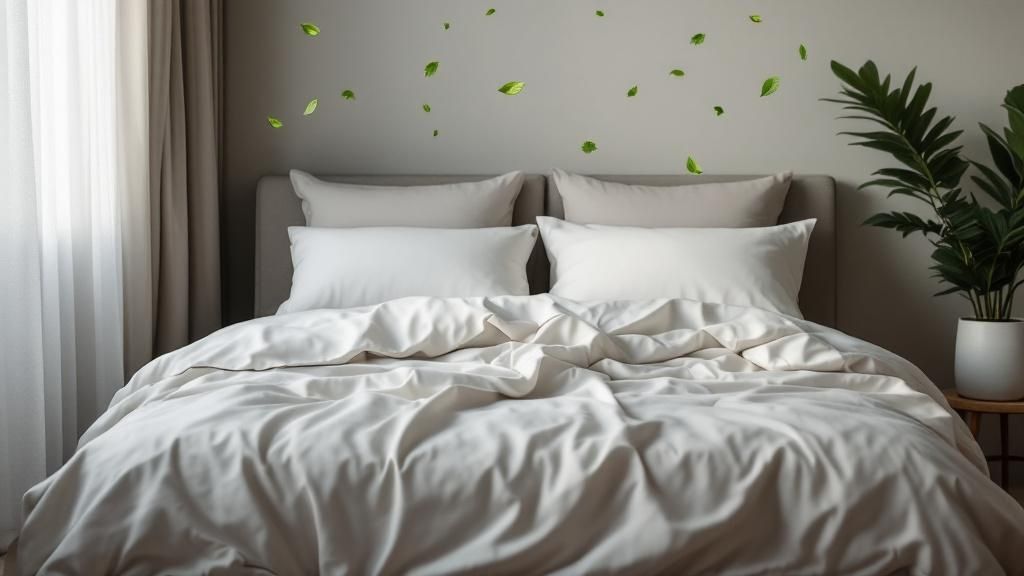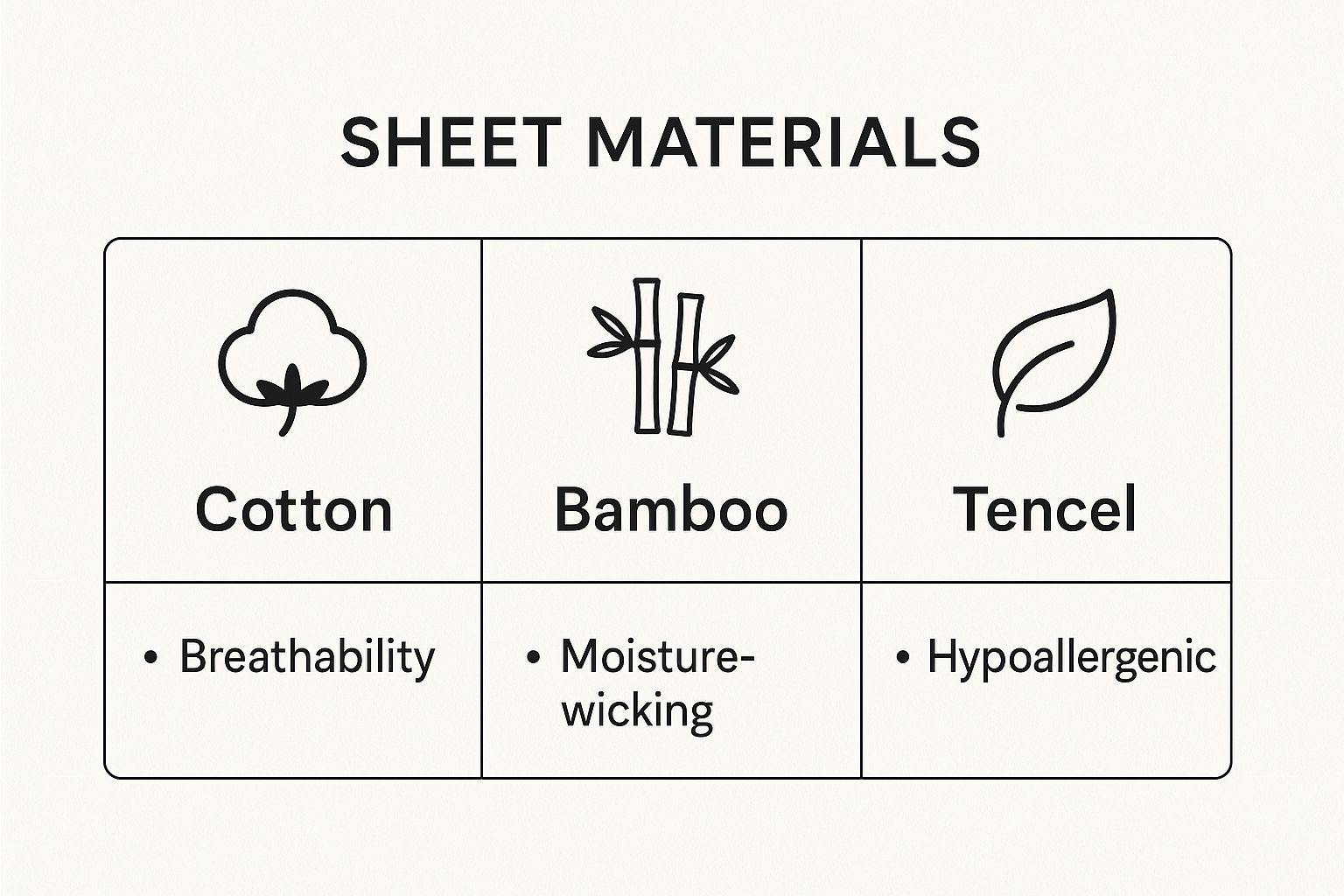If you're constantly waking up congested, with itchy eyes and a general feeling of exhaustion, your bedsheets might be the unexpected villain. I've found that the single best thing you can do is switch to sheets made from tightly woven, breathable fabrics. Materials like Tencel, silk, and bamboo are fantastic because they naturally resist the most common allergens. Their structure creates a powerful barrier against dust mites and prevents moisture from building up, which is crucial for stopping mold and mildew in their tracks.
Your Guide to an Allergy-Free Bed

There’s nothing worse than starting your day with a stuffy nose, irritated skin, or that familiar scratchy feeling in your throat. For so many people I've talked to, the source of this misery is hiding right where they spend a third of their lives—their bed. Over time, your cozy bedding can become a five-star resort for microscopic irritants that just love standard fabrics.
Some of the most common troublemakers lurking in your bedding include:
- Dust Mites: These are by far the biggest offenders. They're tiny creatures that feast on dead skin cells and thrive in warm, humid places (like your bed).
- Pet Dander: If your furry friends share your bedroom, or even just your home, their dander can easily get trapped in loosely woven sheets and blankets.
- Mold and Mildew: Sheets that hold onto moisture create the perfect breeding ground for mold spores to grow and spread.
- Pollen: Especially during allergy season, pollen can drift in through open windows and settle all over your bed, triggering symptoms while you sleep.
Choosing an Effective Material
The real solution is to make your bed as unwelcoming as possible for these intruders. The secret lies in picking sheets made from materials with a naturally tight weave and excellent moisture-wicking properties. Fabrics like Tencel, bamboo, silk, and even high-quality cotton act as a physical shield, making it much harder for dust mites and other allergens to burrow in.
By selecting the right material, you're not just buying new sheets; you're investing in a proactive tool for better respiratory health and more restful sleep. This choice directly impacts your nightly exposure to triggers.
To help you narrow down the options, this table gives you a quick side-by-side look at the top hypoallergenic sheet materials. It breaks down their main anti-allergy features and who might benefit most from each one.
Hypoallergenic Sheet Materials at a Glance
| Material | Key Anti-Allergy Feature | Best For |
|---|---|---|
| Tencel | Extremely smooth, moisture-wicking fibers | Hot sleepers with sensitive skin |
| Silk | Naturally protein-based and tightly woven | Those wanting luxury and skin/hair benefits |
| Bamboo | Antimicrobial and highly breathable | Eco-conscious individuals needing moisture control |
| Cotton | Tightly woven (high thread count) and durable | Anyone looking for a classic, easy-care option |
This comparison should give you a solid starting point for figuring out which fabric aligns with your specific needs. Now, let's take a closer look at what makes each of these materials a great choice for keeping allergies at bay.
Why Your Sheets Might Be Triggering Your Allergies

To win the war against those frustrating nighttime allergies, you have to understand the battlefield. And in this case, the battlefield is your bed. It might look perfectly clean and inviting, but for microscopic irritants, your bedding can become a thriving ecosystem. The main culprit is often something you can't even see.
Allergens like dust mites, pet dander, and mold love to settle into common bedding materials. Dust mites, in particular, are a huge problem because they feed on the tiny skin cells we all naturally shed every night. The warm, humid environment our bodies create during sleep turns your cozy sanctuary into their personal buffet.
How Fabric Can Make or Break Your Sleep
The specific material and weave of your sheets play a surprisingly big role in all this. A loose, open weave—common in fabrics like low-quality polyester or even some flannels—gives dust mites and other allergens plenty of nooks and crannies to burrow into and multiply. These fabrics can also trap moisture, creating the perfect damp environment for mold and mildew to grow.
A fabric's weave is like a fortress wall. A loose weave has open gates, welcoming allergens in. A tight weave, however, presents an impenetrable barrier, stopping them in their tracks.
On the flip side, a fabric with a very tight weave acts as a physical barrier. It makes it nearly impossible for mites to get through, essentially locking them out from your mattress and pillows. This simple structural difference is a key reason why choosing the right sheets can have such a huge impact on your symptoms.
If you want to dive deeper, you can explore our complete guide on the https://bamtekhome.com/blogs/best-sheets-for-allergies to see how different materials stack up.
This growing awareness around sleep health is driving some major changes in the bedding industry. The global home bedding market is projected to reach approximately $119.39 billion by 2025 and is expected to more than double by 2035. Understanding this helps you see past the marketing fluff and choose sheets that genuinely improve your well-being.
Comparing the Best Hypoallergenic Materials
When you're trying to find allergy-friendly bedding, the sheer number of options can feel like a maze. But it gets a lot easier once you understand what makes a fabric truly hypoallergenic. It’s not just about a fancy label; it’s about the very structure of the material and how it actively fights off allergens.
Think about it this way: a thick, fuzzy flannel sheet is like a deep-pile carpet. It’s a perfect hiding spot for dust mites, pet dander, and pollen to settle in and make a home. On the other hand, a tightly woven, smooth fabric is more like a slick hardwood floor—there’s simply nowhere for those microscopic irritants to hide.
Top Contenders for an Allergy-Free Bed
Tencel (Lyocell) is a real superstar in this category. It has an incredibly smooth, silky feel that won't irritate sensitive skin. Made from eucalyptus wood pulp, Tencel fibers are phenomenal at wicking away moisture. This is a huge deal for allergy sufferers because it keeps your bed dry, making it a terrible place for mold and mildew to grow. If you're a hot sleeper who also deals with skin issues, Tencel is an absolute game-changer.
Bamboo is another fantastic choice, and it shares some of Tencel's best qualities. Bamboo sheets are celebrated for their exceptional softness and ability to manage moisture. They’re also naturally antimicrobial, which means they create a surface that's inherently resistant to bacteria and other allergens. To get a closer look at all the top-tier options, our guide to the best hypoallergenic bedding is a great resource.
This quick visual breaks down the core benefits of the leading materials.

As you can see, different materials shine in different areas, whether it's superior breathability or unmatched moisture control—all crucial for keeping allergies at bay.
Classic and Luxury Options
If you're looking for a touch of luxury, don't overlook silk. It's more than just a beautiful fabric; its natural protein structure is inherently resistant to dust mites. The fibers are woven so tightly that they form a barrier that allergens struggle to penetrate. It’s the perfect blend of premium comfort and serious allergen defense.
And of course, there’s always high-quality cotton. The secret here is all in the weave. A tight percale or sateen weave, especially with a high thread count, creates a fabric that’s tough for dust mites to get through. For the best performance, always go for 100% long-staple cotton, which offers the ideal mix of durability and breathability.
Key takeaway: The quality and weave of a fabric matter immensely. A cheap, loose-weave polyester or flannel will actively trap allergens and can make your symptoms worse. Your best bet is always a dense, smooth, and breathable material.
Lately, linen sheets have also become a go-to for many allergy sufferers. Woven from flax fibers, linen is prized for its breathability. It can absorb up to 20% of its own weight in moisture before it even starts to feel damp. This creates a consistently cool, dry sleeping environment where dust mites and mold simply don't stand a chance.
More Than Just the Material: What Else to Look For
Picking the right fabric is a great start, but it's only half the battle. When you're trying to find the best sheets for allergies, the small details on the product label can make a huge difference in how you feel each morning. It's a lot like reading the nutrition facts on your food—you need to know exactly what you're bringing into your bedroom.
One of the first things I always tell people to check for is an OEKO-TEX Standard 100 certification. Think of this as a seal of approval. It guarantees the fabric has been rigorously tested for a long list of harmful chemicals and toxins. If you have sensitive skin or any kind of respiratory issue, this isn't just a nice-to-have; it's essential for ensuring your bedding isn't releasing irritating substances while you sleep.
Why Fabric Weave Is a Game-Changer
Beyond certifications, the actual construction of the fabric is incredibly important. The weave—how the threads are put together—determines how tight the fabric is. A tighter weave acts as a physical shield, making it much harder for dust mites and other tiny allergens to work their way through.
Two weaves, in particular, are fantastic for allergy sufferers:
- Percale: Known for its crisp, cool feel, percale uses a simple one-over, one-under pattern. This creates a very dense, breathable fabric that allergens struggle to get through.
- Sateen: If you prefer something silkier and smoother, sateen is a great choice. Its one-under, three-over pattern also results in a tightly woven fabric, giving you that luxurious feel without compromising on protection.
The right weave is like a bouncer for your bed. A loose, open weave lets all the allergens in, no questions asked. A tight percale or sateen weave, on the other hand, keeps them out.
Creating this physical barrier is really the foundation of the anti-mite bedding industry. The best brands are now incorporating specialized mite-blocking technology and antimicrobial finishes to take sleep hygiene to the next level. You can see just how much these features are shaping the industry by looking at the latest market reports. Get a deeper look into the anti-mite bedding market at datainsightsmarket.com.
How to Keep Your Bedding Allergen-Free

So, you've invested in some top-notch hypoallergenic sheets. That’s a fantastic first move, but it's only half the battle. To keep your bed a true sanctuary from sniffles and sneezes, you need a solid cleaning routine. Without it, those pesky allergens will inevitably creep back in.
Your washing machine is your best friend in this fight. The key is to wash your sheets and pillowcases at least once a week in hot water—and I mean hot. You're aiming for 130°F (54°C) or higher. This specific temperature is the critical threshold for actually killing dust mites, not just rinsing them out.
When you wash, reach for a gentle, dye-free detergent. This helps prevent any skin irritation, which is often a concern for the same people who suffer from allergies.
Your Complete Allergen-Proof Laundry Routine
Once the wash cycle is done, don't underestimate the importance of drying. Tumble dry everything on a low to medium heat setting until every last bit of moisture is gone. Seriously, even a hint of dampness can become a welcome mat for mold and mildew, completely undoing all your hard work.
Think of your sheets as a filter and zippered mattress and pillow encasements as an impenetrable wall. The encasements are your absolute first line of defense, blocking the vast majority of allergens from ever reaching you.
This simple maintenance cycle is what truly protects your investment and makes sure your bed remains a haven for restful, uninterrupted sleep.
And if you've opted for bamboo sheets, they have their own special care needs to maintain their softness and natural hypoallergenic qualities. You can get all the details in our guide on how to care for your bamboo sheets.
Common Questions About Allergy Bedding
I get it—even after you've learned about all the different materials and weaves, some nagging questions can pop up right before you're ready to buy. Let's walk through some of the most common ones I hear from people trying to find relief. Getting these answers straight is the final step to picking the best sheets for allergy sufferers and feeling good about your choice.
Are 100% Cotton Sheets a Good Choice for Allergies?
It’s not so much about the cotton itself, but how it’s woven. A 100% cotton sheet with a really tight, dense construction—think percale or sateen—is fantastic for people with allergies. The threads are packed so closely together that they create a physical barrier, making it tough for dust mites to burrow in.
On the other hand, if you grab a loosely woven cotton like some flannels, you might actually be making things worse. Those looser fabrics have more space to trap dust, dander, and other irritants. So, if you're set on cotton, always look for that tight weave and a higher thread count to get the best protection.
How Often Should I Be Washing My Sheets?
This is a big one. To keep allergens from building up, you need to wash all your bedding at least once a week. Consistency is everything here. It stops dust mites, pet dander, and dead skin cells from accumulating in the place you spend a third of your life.
But just washing them isn't enough; the temperature is critical. You have to use hot water—at least 130°F (54°C). That's the magic number for actually killing dust mites, not just giving them a rinse cycle.
Expert Tip: I always tell people to think of their hypoallergenic sheets as a crucial part of a system. They're a powerful tool, but they work hand-in-hand with a quality mattress encasement for the best results.
Do I Really Need a Mattress Protector, Too?
Yes, without a doubt. A zippered mattress encasement is probably the single most effective thing you can do to allergy-proof your bed. Your mattress is the main breeding ground for dust mites and holds the highest concentration of allergens.
A full encasement seals them in and keeps them away from you. Your sheets then act as the next layer of defense, ensuring your immediate sleep surface stays as clean and irritant-free as possible.
Ready to feel the difference a truly hypoallergenic bed can make? The 100% organic bamboo sheets from Bamtek are a great example of this in action. They're OEKO-TEX certified, naturally moisture-wicking, and incredibly soft, creating an inhospitable environment for allergens while being gentle on sensitive skin. You can transform your sleep into a restful sanctuary by exploring their collection.










